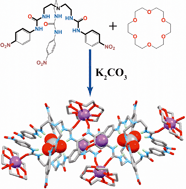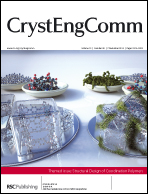A supramolecular dual-host based ion-pair induced formation of 1D coordination polymer†
Abstract
An N-bridged tripodal urea receptor (L1) in combination with 18-crown-6-ether (LC) has been structurally authenticated to self-assemble into an integrated 1D coordination polymer in the presence of potassium carbonate (K2CO3). The tripodal receptor (L1) encapsulates a carbonate anion within a dimeric capsular assembly. A carbonyl group and a nitro group from each tripodal unit of the dimeric assembly are coordinated to each crown ether bound potassium ion, generating a 1D coordination polymer. Thus, an anion-pair induced 1D integrated polymeric assembly is formed based on two hosts in combination.

- This article is part of the themed collection: Structural Design of Coordination Polymers

 Please wait while we load your content...
Please wait while we load your content...